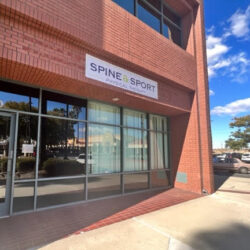The basics of workers’ compensation
- Workers’ compensation is an insurance policy held by an employer providing medical treatment and compensation to employees injured on the job.
- Common workplace injuries can include slips, falls, breaks, lifting injuries, contact with machinery and overexertion, among other issues.
- Treatment depends upon the specific injury and can include physical therapy, work conditioning, ergonomics and other evaluations to determine when the employee may safely return to work.
Move forward, faster, fearlessly
What is workers’ compensation?
Workers’ compensation, commonly known as workers’ comp, is an insurance held by an employer that covers employees with work related injuries for medical expenses and lost wages while they recover. According to the Bureau of Labor Statistics, companies reported 2.7 million workplace injuries in 2020.
Workers’ compensation specifically covers work related injuries but is not health insurance, which is broader coverage of health issues occurring outside the workplace or preventive health measures. Workers’ comp is regulated on the state level, and each state has its own requirements and penalties. In California, workers’ comp is mandatory for all employers and is managed by the Division of Workers’ Compensation.
There are many types of injuries and illnesses that can result in a workers’ compensation claim.
Workplace injuries are common and can range from mild pain to severe disability. Seeking medical attention early is important for an accurate diagnosis, proper treatment and coverage under a workers’ compensation claim.
The most common workplace injuries
The top three leading causes of workplace injuries are overexertion, slips/trips/falls and contact with machinery or equipment. These account for roughly 84% of all nonfatal injuries that result in time off of work.
Leading workplace injuries and illnesses include:
- Lower back disorders.
- Neck and upper back injuries.
- Herniated disks and more serious spinal injuries.
- Upper and lower extremities sprains, breaks and strains.
- Repetitive stress and tendinitis.
- Carpal tunnel syndrome.
- Crush injuries.
- Epicondylitis (tennis elbow).
- De Quervain’s tenosynovitis.
- Osteoarthritis.
- Hernias.
- Concussions.
- Lacerations.
- Musculoskeletal disorders/disfunction (MSDs).
- Skin irritants and allergic reactions.
- Traumatic injuries.
Workers’ comp services and physical therapy treatment
We can help with those injuries that require physical therapy. Spine & Sport offers several programs to not only get patients back to work safely but also to screen or help prevent future injuries on the job.
Physical therapy to treat work-related injury
Depending on the injury, standard therapy may include:
- Education and expectations about recovery.
- Baseline testing and work performance testing.
- Aerobic capacity measurement and training.
- Balance training activities.
- Occupational therapy from a Certified Hand Therapist.
- Post-concussion exertion therapy.
- Functional training and work task simulation.
- Manual therapy (hands-on).
- Stretching and strengthening exercises.
- Higher level isolated strengthening.
Therapists spend a great deal of time showing workers’ comp patients how to properly perform exercises to improve their strength, help them safely return to work, and to prevent further injury.
Workplace ergonomics and injury prevention
Workplace ergonomics is the science of workplace design based on the limitations and capabilities of workers. Workplace ergonomics fits the job to the person, with the goal of preventing MSDs.
Ergonomic training focuses on evaluating a specific job’s tasks and environment to identify risk factors that could result in musculoskeletal dysfunction. MSD injuries such as strains, carpal tunnel syndrome and back injuries are some of the most common workplace injuries, as many tasks like repetitive movements or lifting are commonplace.
Ergonomics training helps educate patients on the importance of proper posture and appropriate workplace setup. This lessens muscle fatigue, increases productivity and reduces the number and severity of work-related MSDs.
Work conditioning & preventing re-injury
The emphasis of work conditioning is not just treating the injury but helping the patient achieve a full return to work. Conditioning programs are appropriate for workers who are still unable to return to full capacity 30+ days after injury and for those who are not able to achieve the functionality required with traditional physical therapy. We specialize in higher intensity training to help industrial athletes return to work.
Work conditioning can enable employees to remain at work while recovering from an injury if possible. If that’s not possible, it helps employees regain their ability to perform job-related tasks safely and efficiently so they can return to work as soon as possible.
Conditioning focuses on restoring previous levels of endurance, coordination and flexibility to aid in preventing re-injury. This program includes performance testing to get a baseline for the injured worker. Following that, the physical therapist develops a targeted strengthening and conditioning program that simulates the person’s normal work tasks.
We administer performance testing on a regular basis in order to measure progress and ensure that the worker is safe to return to work. These full-body, intensive programs have a positive impact on the rate at which employees remain at work or return to work after injury, getting them back to productivity sooner than they would without therapy.
An effective work conditioning program will help employees to regain their working capacity, functional abilities, strength and mobility.
EPIC Lift Capacity (ELC) evaluation
The ELC tests a person’s ability to lift, including frequency, duration and distance. It is often used to establish a worker’s maximum acceptable lift weight after an injury.
Functional capacity evaluations (FCEs)
These assessments measure physical abilities and tolerance levels to determine when patients are able to safely return to work. Data gathered through this evaluation objectively defines the injured employee’s physical capabilities.
The service includes assessing behavioral and physical factors contributing to a patient’s capacity for work, such as endurance, posture, coordination and strength. It is a valuable evaluation tool to determine a patient’s treatment goals and path to recovery.
Multidimensional Task Ability Profile (MTAP)
The MTAP is a work-related questionnaire that measures the patient’s current level of function and compares that to his or her occupational demand. It tracks the patient’s progress over time to help determine baseline function and establish the proper dosing of work tasks.
The MTAP easily illustrates any progress, decline or plateau in function, which is instrumental in helping the patient return safely to work.
Timeline for getting back to work after an injury
Every individual and his or her injury is different. Therefore, the treatment plans are customized to serve the patient’s specific rehabilitation needs. The timeline of progress depends on the injury, condition and dedication of the patient.
Get informed about getting back to work
Spine & Sport Physical Therapy’s workers’ compensation program can help speed up the recovery process and get injured workers back to their full range of motion and ability. Learn more about conditions and options.
-
Occupational therapy helps people of all ages maintain independence & engage in
daily activities despite injury, illness or disability. -
Regaining movement, easing pain and improving quality of life – these are just a few
of the benefits of physical therapy. Learn how PT can help you.
Spine & Sport clinics offering workers’ comp services near me
All of our clinics in Southern & Northern California offer physical therapy for workers’ compensation and work-related injuries.


 South San Diego County
South San Diego County Central San Diego County
Central San Diego County East San Diego County
East San Diego County North San Diego County
North San Diego County Orange County
Orange County Imperial County
Imperial County Coachella Valley
Coachella Valley Riverside County
Riverside County Ventura County
Ventura County Los Angeles County
Los Angeles County Northern California
Northern California